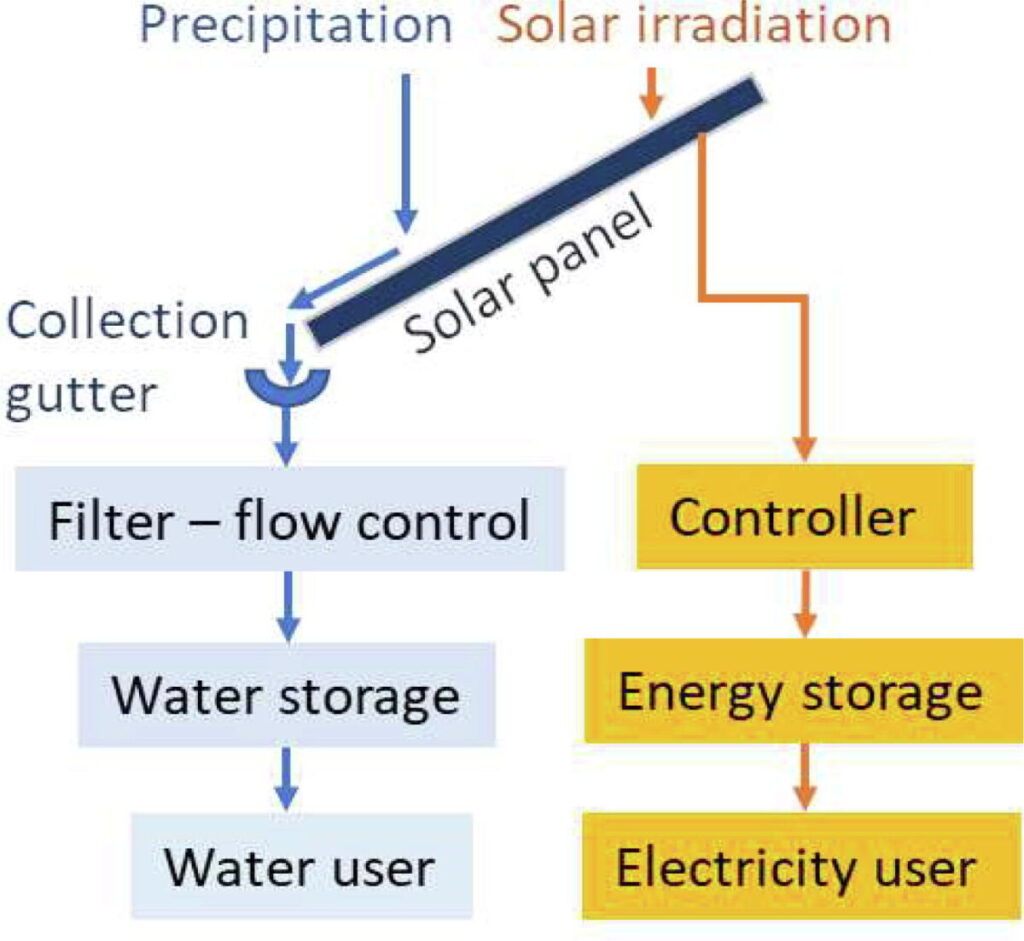Scientists have developed a system that harvests rainwater from PV panels for the use of households or hydrogen production. Their analysis showed that the system in the southern Sahel can meet both energy and water requirements for electrolysis, where excess rainwater up to 50% of the daily water demand of a household.
A European team of researchers has proposed a system that rainwater harvests PV panels for the use of households or hydrogen production.
“The combined water and energy shelter by PV-mini-grids can have the potential to increase water security by making more water available for domestic use or crop irrigation in the dry season,” the researchers said. “The potential of PV systems for simultaneous water and energy supply in the Sahel has not yet been studied.”
The water collection system that the team had designed uses PV arrays with fixed tilt. A primary gutter is placed under each array and collects the water that runs from the panel. These are then aimed at a secondary water transport system that connects PV panel units with filtration and water storage facilities.
The team has adopted a 1 mm water storage loss on the panel, which means that rainwater is stuck or out of the panel before it can be collected. They also adopted a discharge coefficient of 0.9, which means that 90% of the water that falls on the panel is collected. They continued with a first loss of 3 mm, which means that the first pair of millimeters that fall on the panel after a dry spell are infected with soil and therefore could not be used. The analyzed area looks at two areas – the Sahel region and the Sahel Eigen.
After designing the system, the academics calculated are water harvest and energy production potential in the Sahel region of Africa. A thorough delivery of the energy demand, such a system can contribute up to 7% of the demand for household water, they found.
The Sahel-Region comprises parts of Mauritania, Senegal, Gambia, Guinea-Bissau, Guinea, Sierra Leone, Mali, Algeria, Cote d’IVoire, Burkina Faso, Ghana, Togo, Benin, Niger, Nigeria, Camaloon, Sdan, Libya, Libya, Libya, Libya, Libya, Libya, Libya, Libya, Libya, Libya, Ethiopia, Djibolia, Djibolia, Djibolia, Djibolia, Djibolia, Djibolia, Djibolia, Djibolia.
“The selected region also includes parts of Saudi Aarabia, Yemen and Oman in the east, which are not in the Sahel. Moreover, the northern part of the size also includes dry parts of the Sahara desert,” the group explained. “The actual Sahel is defined here as the area within the average annual precipitation contours of 150 and 850 mm.”
Image: Acacia Water, Water-Energy Nexus, CC by 4.0
Based on the data from the relevant countries, the researchers considered a household of 6.9 people, which uses 136 liters of water per day and 4.5 kWh of electricity. To meet the electricity requirements of the Sahel area, a PV surface of 4.1 m² is needed in the dry north and almost 6.0 m² in the moist south. That surface is then used as a factor to calculate how much water runs from the panel to the storage space. Precipitation and radiation values came from weather databases.
“The net rainwater eyelock potential was negative in the Sahara desert where interception losses and cleaning water needs exceed the precipitation input,” the results showed. “The percentage of the demand for household water that may have been supplied by the rainwater varied from about 1% along the northern border to about 7% along the southern border. To the south of the Sahel percentages are larger than 20% due to higher precipitation entrances and the higher PV panel surface.”
In addition, the group calculated the power of such household PV systems to deliver both electricity and rainwater to produce 1 kg of hydrogen per day. According to their analysis, the system in the southern Sahel can meet both energy and water requirements for electrolysis, where excess rainwater up to 50% of the daily water demand of a household. Even higher surpluses – more than 100% of the needs of the household water – were calculated for regions south of the Sahel, including Nigeria, Burkina Faso, Benin and Northwesternethiopia.
Their findings were presented in “Rainwater harvest potential of photovoltaic energy systems in the Sahel“Published in Water energy Nexus. Researchers from the Consultancy of the Netherlands Acacia Water, the IHE Delft Institute for Water Education and the Spanish water technology center Cetaqua contributed to the research.
This content is protected by copyright and may not be reused. If you want to work with us and reuse part of our content, please contact: editors@pv-magazine.com.
Popular content


